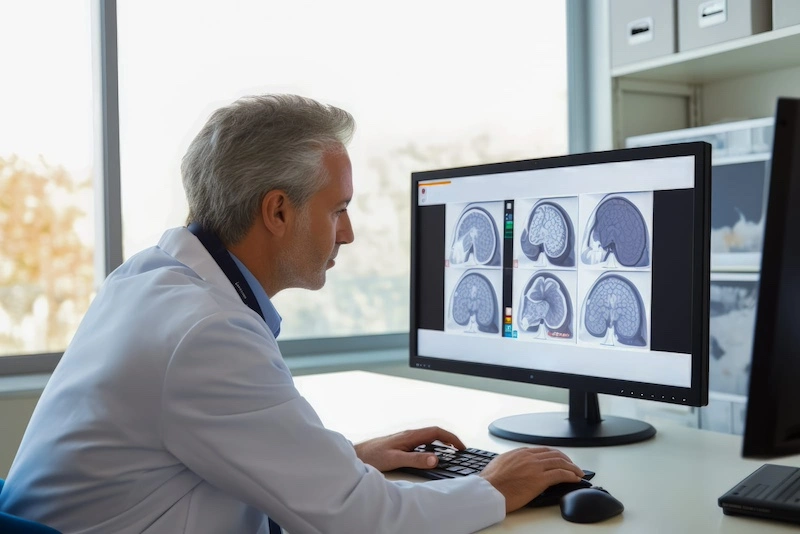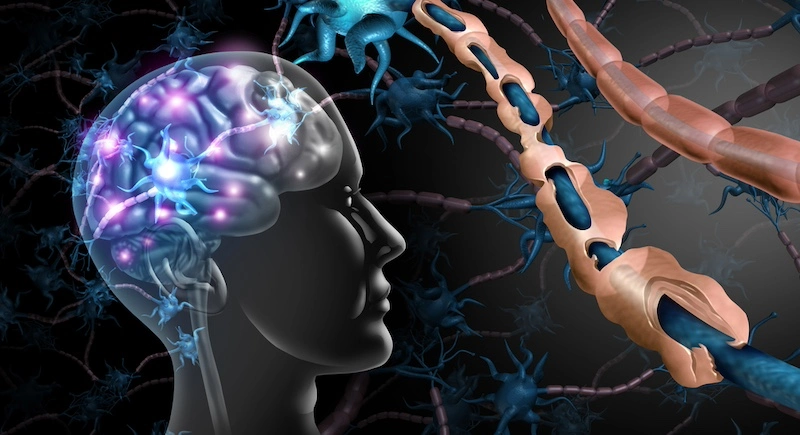Multiple sclerosis is an inflammatory disease that affects the central nervous system and causes chronic neural degeneration. The changes to the central nervous system impede communication between the body and the brain, causing several different symptoms throughout the course of the disease.
Today there is growing interest in non-invasive neuromodulation techniques for managing neurological conditions, especially for MS. One such option is transcranial magnetic stimulation.
TMS as a potential treatment for multiple sclerosis
How does TMS for multiple sclerosis work? Is it safe and effective?
Understanding Multiple Sclerosis
Multiple sclerosis (MS) is a disease that affects the central nervous system and causes inflammation and demyelinating lesions. It can result in several impairments and symptoms, including:
- Pain
- Fatigue
- Spasms
- Movement disorders
- Cognitive impairment
All of these have a negative impact on quality of life and how long patients are expected to live. Right now, the most common treatment involves drug therapies, but these continue to produce subpar results when it comes to stopping the progression of disabilities. Combining these drugs with other non-drug therapies like TMS for MS has offered a novel therapeutic form of care.
Introduction to Transcranial Magnetic Stimulation (TMS)
Transcranial magnetic stimulation is a non-invasive form of brain stimulation. It has been approved by the FDA as a treatment for major depressive disorder and continues to be a viable non-pharmacological treatment option for things like:
- Anxiety
- Addiction
- Ischemic stroke recovery
- Neuropathic pain
- Parkinson’s disease
- Personality disorders
- Depression
- Eating disorders
The device relies on a pulsed magnetic field with coils that are placed over the corresponding part of the brain and magnetic pulses sent into the brain. These pulses can penetrate deeper regions of the brain where inadequate blood flow, inflammation, or other problems are inhibiting neural function. Such stimulation can encourage cellular regeneration, better neural connectivity, and Improvement in secondary and tertiary symptoms.

Mechanisms of TMS in Multiple Sclerosis
TMS MS treatment uses electromagnetic induction. An electric pulse generator with a coil is placed on the head and magnetic pulses are sent through the brain in a non-invasive way which induces activity in the underlying neurons and neural tissues.
In a painless process, MS TMS can be applied over specific areas to activate cortical fibers that are contributing to major symptoms. The primary area where TMS MS treatment works is the motor cortex.
TMS multiple sclerosis treatment has been employed as an alternative way to help improve the neurophysiological symptoms of MS, which are not the result of structural damage.
Clinical Evidence and Research Findings
People who struggle with MS can struggle with extreme inflammation, which changes their synaptic transmissions and promotes hyperexcitability and neural damage. TMS for multiple sclerosis can promote anti-inflammatory molecules throughout the spine and the brain, which help to reverse all three of these issues and reduce or, in some cases, alleviate symptoms like fatigue.
A systematic review of existing literature found that the effects of TMS for MS offer great short-term promise.
Other literature reviews confirmed that when electromagnetic pulses are applied to certain areas of the brain it can optimize functional brain activity including nerve impulse transmission through demyelinated corticospinal pathways, something that is a significant problem with those who have multiple sclerosis. Some of the literature in this review has investigated the use of conventional TMS to treat fatigue in particular and shown great promise.
Research has confirmed that TMS offers a painless, non-invasive way to treat different MS symptoms by targeting different regions of the brain until they are relatively stable. Both low-frequency and high-frequency TMS for MS can alter the following:
- Excitability of the resting cortex
- Functional activity of neurons
- Transmission of neurotransmitters
Challenges and Considerations
One of the biggest challenges is that the effects of TMS multiple sclerosis treatment last an average of six months. This means it is short-term relief only. Given that MS is a progressively degenerative condition, this means individuals will need to incorporate TMS into their regular routine at least once per year, though for some patients, two or three times.

Combining TMS with Other Therapeutic Approaches
Given the high efficacy but limited lifespan for the results, it is best to continue combining TMS for MS with other therapies. Those who struggle with MS should continue with other rehabilitation, therapy, or medication as suggested by their care team.
There are no adverse effects or contraindications for combining TMS MS treatment with other care, which means it can be combined with several other treatment options without risk. If you are considering TMS for MS, it is something that you should speak with your care team about so that they can monitor progress and make accommodations or adjustments to other treatment programs or therapies accordingly.
Patient Perspectives and Experiences
According to several studies, patients have found that TMS multiple sclerosis treatment offers relief from things like pain, spasms, and fatigue. Depending on the area that is stimulated, patients have reported positive changes in many other symptoms as well.
The length of time that the symptoms are relieved will vary from one patient to another, so it’s important that patients monitor the positive impact that TMS has on certain symptoms and be aware that when those symptoms manifest again, it’s an indicator that additional TMS sessions are required.
Individual experiences note that the process is simple and painless. Sessions last no more than 20 minutes, and the side effects are limited to mild headaches or tingling at the site of the magnetic pulses. Given the non-invasive nature of the procedure, recovery was simple, and individuals saw results within the first several weeks of their regular appointments.
Summing Up
Today, TMS multiple sclerosis treatment is a promising adjunctive therapy for those with MS. This non-invasive process can be most effective when used in conjunction with other treatment plans to limit the progression of disabilities and control the more severe symptoms of multiple sclerosis. It is important that continued research and clinical exploration are supported in order to enhance our understanding of TMS in MS management.
